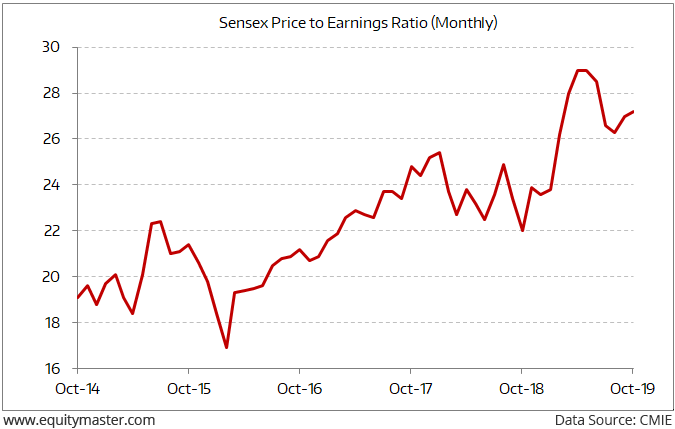India's Third Giant Leap
This Could be One of the Biggest Opportunities for Investors
- Home
- Todays Market
- Indian Stock Market News December 3, 2019
Indian Stock Markets Open Flat; Metal and Telecom Stocks Lag Tue, 3 Dec 09:30 am
Asian stock markets are lower today as Japanese and Hong Kong shares fall. The Nikkei 225 is off 0.9% while the Hang Seng is down 0.2%. The Shanghai Composite is trading down by 0.3%. Wall Street stepped back from last week's record highs on Monday, with weak US manufacturing data and fresh trade worries keeping buyers on the sidelines.
Back home, India share markets opened marginally down. The BSE Sensex is trading down by 68 points while the NSE Nifty is trading down by 19 points. Both, the BSE Mid Cap index and BSE Small Cap index opened up by 0.1%.
Sectoral indices have opened the day on a mixed note with consumer durables and automobiles stocks witnessing buying interest. Metal and telecom stocks are trading in red.
Speaking of the Sensex above 40,000 levels, how expensive is the Sensex? What has the trend been in recent years?
It would be interesting to see how the valuation of the index has moved over the last five years.
The chart below maps the price to earnings ratio of the Sensex from October 2014 to now.
How Pricey Is the Sensex Now?
Here's what Ankit Shah wrote about this in one of the editions of The 5 Minute WrapUp...
- It is worth noting that the Sensex has gained 44% over the last five years, compounding at an annual rate of 7.6% (excluding dividends).
Not quite impressive.
During the same period, the Sensex price to earnings ratio has mostly been in a rising trend, except some intermittent declines.
Between October 2014 and now, the gain in the Sensex price to earnings ratio is 42%. That means that the gains in the index have mostly come from expansion in the valuation multiple, and just meagerly from increases in earnings.
So, before taking the current market bullishness for granted, do weigh in the fact that the Sensex is quite expensively priced.
Moving on, the rupee is currently trading at 71.60 against the US$.
The rupee, on Monday, settled 8 paise higher at 71.66 against the US dollar amid participants hoping the RBI will go in for another rate cut in the ensuing RBI policy review meet this week.
Reportedly, the domestic currency opened weak as investors traded cautiously after India's Q2 GDP growth dipped to an over six-year-low of 4.5%, but during the day, the local unit gathered strength anticipating further easing in key rates to boost the slowing economy.
At the interbank foreign exchange, the rupee opened weak at 71.78 a dollar, but soon gathered strength to touch a high of 71.62 before finally settling at 71.66, up 8 paise over its last closing.
The rupee had closed at 71.74 against the US dollar on Friday.
Moving on to the news from pharma sector. As per an article in a leading financial daily, Biocon has launched Trastuzumab biosimilar Ogivri in the US market, bringing access to another biosimilar.
Ogivri, a biosimilar to Herceptin, has been co-developed by Biocon Biologics and Mylan and will be available in 150 mg and 420 mg strengths.
Ogivri will be launched at a competitive discount for customers to help ensure access and increase treatment options for patients, the company stated.
Ogivri is used to treat breast cancer and gastric cancer and Biocon has regulatory approval to sell it in more than 80 countries worldwide.
It is the second biosimilar from the partnered portfolio of Biocon and Mylan being commercialised in the US.
Last year, Biocon had launched Fulphila, a biosimilar Pegfilgrastim which is used to stimulate bone marrow to produce more neutrophils to fight infection in patients undergoing chemotherapy.
Biocon Biologics currently has a product pipeline of 28 molecules, including 11 partnered with Mylan, several with Sandoz and many being developed independently.
The company recently received a USFDA approvals for supplemental Biologics License Applications, expanding the manufacturing capability for Ogivri and Fulphila.
Reportedly, the US biosimilars market is projected to reach US$17,696 million by 2026 and grow at a CAGR of over 50% between 2019 and 2026.
Multinational pharma giant Pfizer too received approval from FDA for Trazimera, a biosimilar referencing Herceptin in March this year and has plans to commercialise the product by February 2020.
Speaking of the biosimilars, note that, biosimilars and biologics are burgeoning sectors. Also, major scientific and technological advances, coupled with socio-demographic changes and increasing demand for medicines will revive the pharma industry's fortunes in another 10 to 20 years.
But given the complexity of biologics, will Indian companies be able to break some ground in this space?
Going forward, whether the monetization of biosimilars prove to be a big growth driver for the company will be the key thing to watch out for.
Biocon share price opened the day up by 2.2%.
To know what's moving the Indian stock markets today, check out the most recent share market updates here.
For information on how to pick stocks that have the potential to deliver big returns, download our special report now!
Read the latest Market Commentary



Equitymaster requests your view! Post a comment on "Indian Stock Markets Open Flat; Metal and Telecom Stocks Lag". Click here!
Comments are moderated by Equitymaster, in accordance with the Terms of Use, and may not appear
on this article until they have been reviewed and deemed appropriate for posting.
In the meantime, you may want to share this article with your friends!